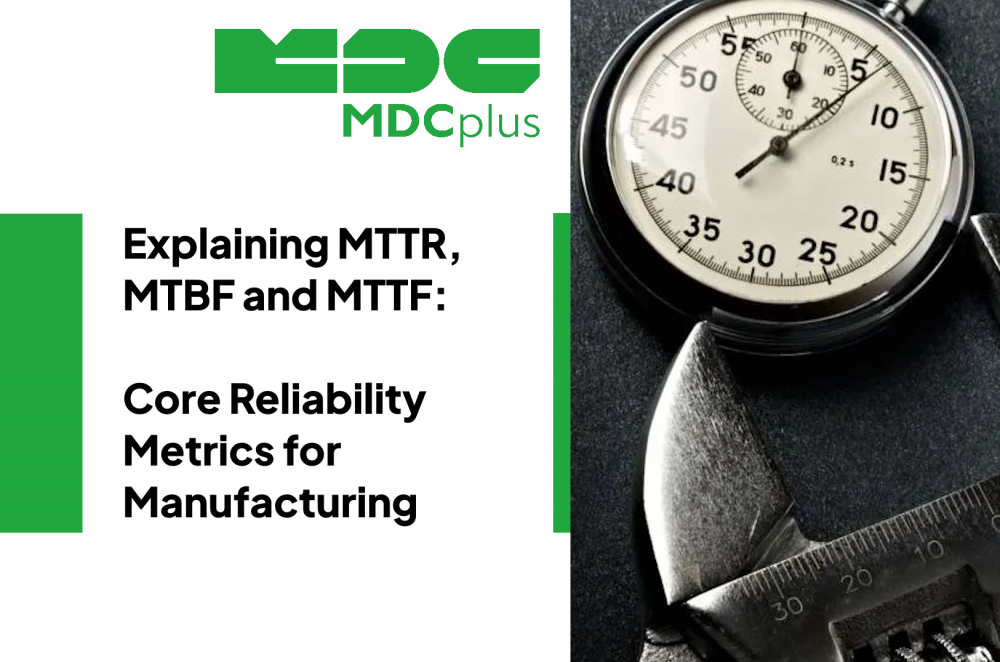Explaining MTTR, MTBF and MTTF – Core Reliability Metrics for Manufacturing
Among the most widely used are MTTR (Mean Time to Repair), MTBF (Mean Time Between Failures), and MTTF (Mean Time to Failure). Together, they provide a framework for measuring equipment uptime, planning maintenance, and improving operational efficiency.
What is MTTR (Mean Time to Repair)?
Definition: MTTR measures the average time it takes to repair equipment and restore it to full operation after a failure.
-
Formula:
MTTR = Total Downtime for Repairs ÷ Number of Repairs -
Why it matters:
-
Indicates how quickly maintenance teams can respond
-
Affects total machine availability and OEE
-
Helps identify bottlenecks in maintenance processes
-
Example: If a CNC machine fails 5 times in a month and the total repair time is 25 hours, the MTTR is 5 hours.
What is MTBF (Mean Time Between Failures)?
Definition: MTBF measures the average operating time between one failure and the next. It’s a reliability indicator used for repairable systems.
-
Formula:
MTBF = Total Operating Time ÷ Number of Failures -
Why it matters:
-
Reflects reliability of equipment under normal use
-
Helps predict maintenance intervals
-
Useful in spare part planning and warranty analysis
-
Example: A production line operates 1,000 hours in a quarter and experiences 5 breakdowns. The MTBF is 200 hours.
What is MTTF (Mean Time to Failure)?
Definition: MTTF is the average time a non-repairable component operates before it fails. Unlike MTBF, once an item fails, it must be replaced.
-
Formula:
MTTF = Total Operating Time ÷ Number of Units Failed -
Why it matters:
-
Commonly applied to consumables (bearings, fuses, filters)
-
Guides replacement schedules before unexpected downtime occurs
-
Improves lifecycle cost planning
-
Example: If 100 bearings are tested and together they last 50,000 operating hours before failure, the MTTF is 500 hours.
MTTR vs MTBF vs MTTF – Key Differences
| Metric | Applies to | Focus | Higher Value Means |
|---|---|---|---|
| MTTR | Repairable equipment | Repair speed | Slower response (worse) |
| MTBF | Repairable equipment | Reliability between failures | More reliable |
| MTTF | Non-repairable parts | Lifetime before failure | Longer life expectancy |
Why These Metrics Matter in Manufacturing
-
Uptime & Efficiency: Together, they drive machine availability, a key input for OEE (Overall Equipment Effectiveness).
-
Maintenance Planning: Knowing MTBF and MTTF helps schedule preventive replacements, while MTTR shows how fast repairs restore production.
-
Cost Reduction: Predictable lifetimes reduce emergency downtime and lower spare parts inventory costs.
-
Benchmarking: Plants can compare equipment performance across lines, sites, or vendors.
How to Use These Metrics Effectively
-
Collect Reliable Data: Use machine monitoring or MES tools to capture failures and repair times automatically.
-
Identify Patterns: High MTTR may point to skill gaps or poor spare parts availability. Low MTBF could indicate design flaws or improper usage.
-
Act Proactively: Replace components before MTTF runs out. Adjust PM schedules using MTBF data.
-
Integrate into OEE Dashboards: Linking these reliability metrics into OEE and downtime dashboards gives a real-time view of production health.
Key Takeaway
MTTR, MTBF, and MTTF form the core reliability toolkit for manufacturers. They measure repair speed, failure intervals, and part lifespans — together offering a practical way to reduce downtime and improve machine availability. By tracking and applying these metrics, factories can shift from reactive to proactive maintenance and sustain higher production performance.
About MDCplus
Our key features are real-time machine monitoring for swift issue resolution, power consumption tracking to promote sustainability, computerized maintenance management to reduce downtime, and vibration diagnostics for predictive maintenance. MDCplus's solutions are tailored for diverse industries, including aerospace, automotive, precision machining, and heavy industry. By delivering actionable insights and fostering seamless integration, we empower manufacturers to boost Overall Equipment Effectiveness (OEE), reduce operational costs, and achieve sustainable growth along with future planning.
Ready to increase your OEE, get clearer vision of your shop floor, and predict sustainably?
